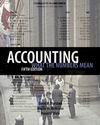 |  Accounting: What the Numbers Mean, 5/e David H. Marshall,
Millikin University
Wayne W. McManus,
International College of the Cayman Islands
Daniel F. Viele,
Webster University
Financial Statements and Accounting Concepts/Principles
Chapter 2 Learning ObjectivesAfter studying this chapter, you should understand:
1.The kind of information reported on each financial statement and the way financial statements are related to each other. |
 |  |  | 2.What transactions are and the meaning and usefulness of the accounting equation. |
 |  |  | 3.The meaning of each of the captions on the financial statements illustrated in this chapter. |
 |  |  | 4.The broad, generally accepted concepts and principles that apply to the accounting process. |
 |  |  | 5.Why investors must carefully consider cash flow information in conjunction with accrual accounting results. |
 |  |  | 6.Several limitations of financial statements. |
 |  |  | 7.What a corporation's annual report is and why it is issued. |
 |  |  | 8.Business practices related to organizing a business, fiscal year, par value, and parent-subsidiary corporations. |
|


 2002 McGraw-Hill Higher Education
2002 McGraw-Hill Higher Education